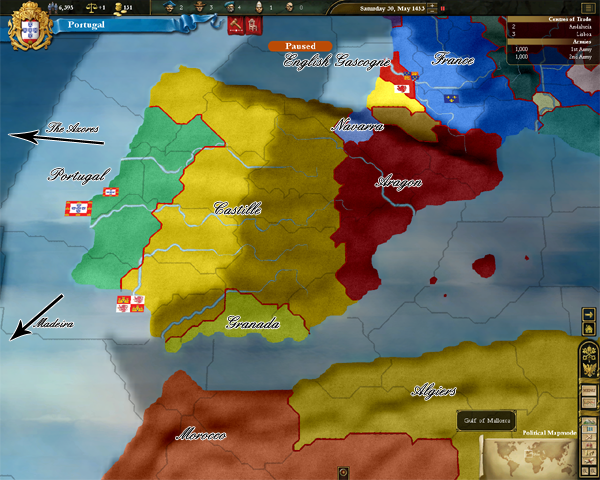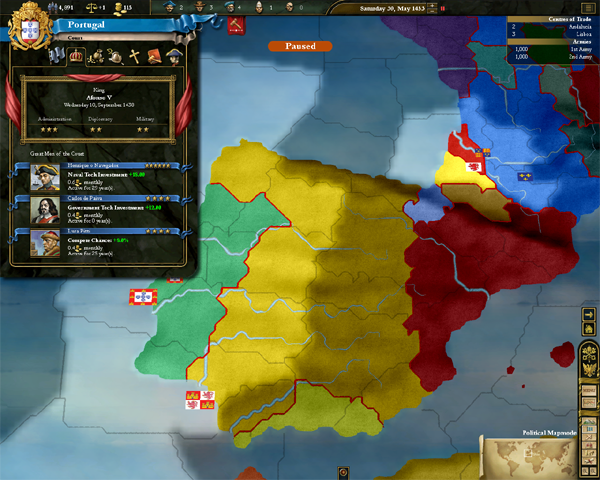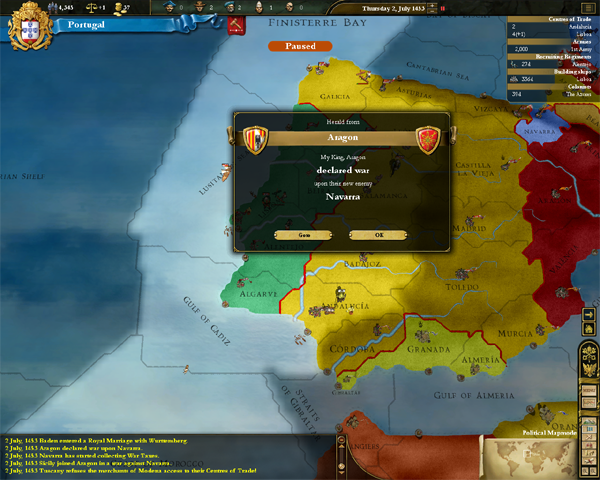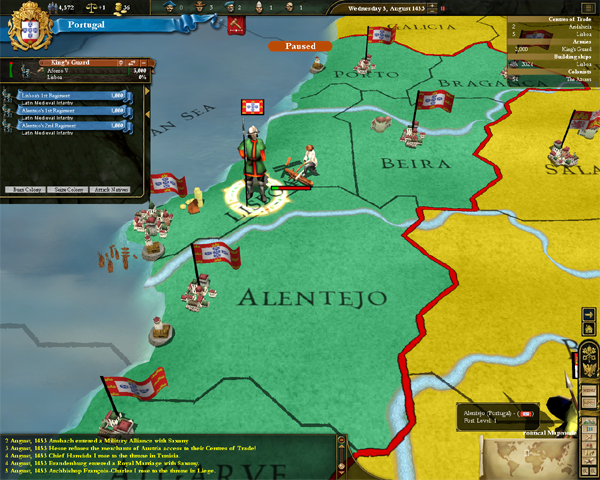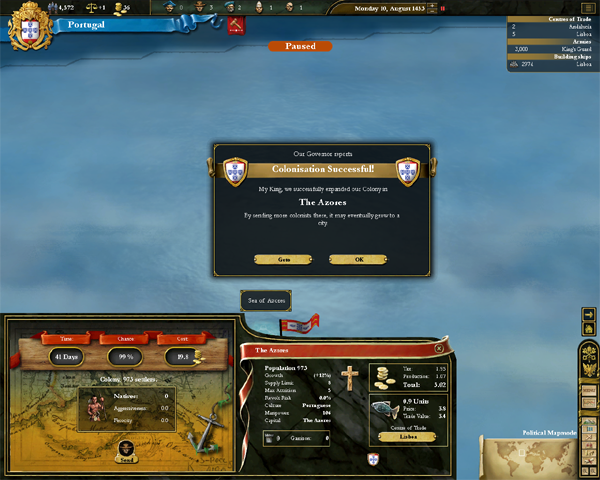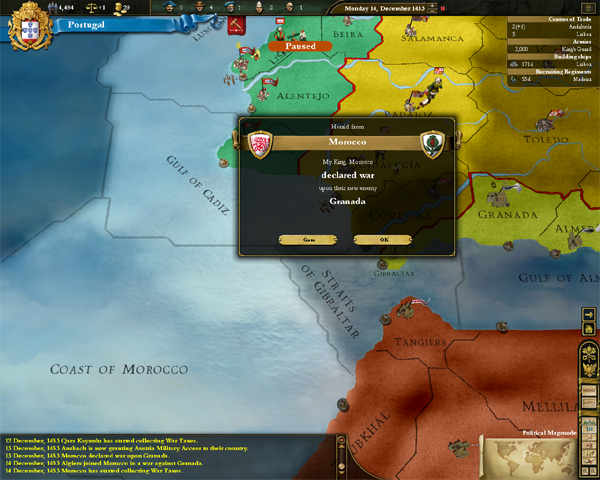
PROLOGUE
Western Iberia: to AD 1179
The early history of Portugal is shared with the rest of the Iberian Peninsula. The region is visited by Phoenicians and Carthaginians, settled by Celts, incorporated in the Roman Empire (as Lusitania in 138 BC), settled again by Visigoths and conquered by Muslims.
During the centuries of the Reconquest, the region has the status of a county. The count of Portugal, owing allegiance to the king of Leon, is on the Atlantic front in the unending struggle against the Muslims. His Christian duty and his own interests coincide in an urge to extend his frontier southwards.
A victory over the Muslims at Ourique in 1139 is traditionally taken as the occasion when Portugal is transformed from a county into a kingdom. In the story the exultant soldiers proclaim their count, Afonso Henriques, as king. He begins calling himself Afonso I of Portugal.
Reality is less abrupt than in the story, but the transformation does occur during the reign of Afonso Henriques. By 1143 his independence is accepted by his cousin and feudal overlord, the king of Leon. In 1179 the new kingdom is formally acknowledged by the pope.
Reconquest: AD 1064-1249
The city of Coimbra, used as their capital by Afonso I and his immediate successors, has been securely in Christian hands since 1064. But an even more significant recovery is made during Afonso's own reign. In 1147 he is poised to attack Lisbon on the great inlet of the river Tagus. For this assault he requires naval strength. He finds it in an unexpected quarter.
The pope has been preaching a new crusade to the Holy Land, and a fleet bearing English warriors - together with some from Flanders - sets sail from northern Europe in the late spring of 1147. In June bad weather forces them to shelter in Portugal.
It is immediately pointed out to them that they need not travel all the way to the Holy Land to kill Muslims. They can do so more easily here, and win land for themselves too. The crusaders and their ships are diverted into besieging Lisbon.
After four months of fierce hostilities, the Muslims in the city surrender on a promise that their lives are safe. The crusaders, as often elsewhere when a city of infidels falls to them, break their word and indulge in a general massacre.
Some of the crusaders continue on eastwards, but the majority settle in this new extension of the Portuguese kingdom. An English priest, Gilbert of Hastings, becomes bishop of the recovered see of Lisbon. These events of 1147 are the first of many links between England and Portugal.
The reconquest of Portugal, down to the southern coast of the Iberian Peninsula, is completed in 1249 with the capture of Faro. In 1256 the capital of the kingdom is transferred from Coimbra to Lisbon. Two centuries later Lisbon's superb natural harbour is the launching point for Europe's new era of maritime exploration. By then the throne belongs to a new dynasty, the house of Avis.
John I and the house of Avis: AD 1385-1433
The seizing of the throne by John I lies at the start of two centuries of outstanding Portuguese achievement. He is brought to power on the crest of a wave of national sentiment, resisting domination by neighbouring Castile.
John is an illegitimate son of the previous king, Ferdinand, who dies in 1383. Ferdinand's daughter, Beatriz, is married to the king of Castile - so it is expected that the two crowns will now be merged. Instead John mounts a revolution which brings two years of humiliation for the Castilians. Lisbon withstands a five-month siege from their forces in 1384. The climax of the campaign is a Portuguese victory in 1385.
The great Dominican abbey known variously as Batalha ('battle') or Santa Maria da Vitória ('St Mary of Victory') is the triumphal celebration of the battle of 1385, fought nearby at Aljubarrota, which secures the kingdom of Portugal for John I. The victory hastens the end of the war against his Castilian rival, four months after John has himself been acclaimed king by the Cortes in Coimbra.
As a child of seven, John was appointed master of the Order of St Benedict of Avis, a Portuguese order of knights founded in the 12th century in the spirit of crusade against the Muslims. From this appointment the new dynasty is known as the House of Avis.
The founder's chapel at Batalha contains the tomb of John I himself, together with those of his wife Philippa of Lancaster and of his son Prince Henry the Navigator.
An English wife and a son with an interest in navigation - the two themes are central to the era now beginning in Portugal.
The English connection: AD 1371-1387
A link between England and Portugal goes back to the recapture of Lisbon in 1147, but it becomes particularly strong in the late 14th century - largely through the activities of John of Gaunt.
Gaunt's involvement stems from his second marriage, in 1371, to the heiress of the king of Castile. Her father has been murdered two years previously by a bastard half-brother who has usurped his throne. Gaunt, with a chance to win Castile for himself, begins to play a role in Iberian politics. His opposition to the present regime in Castile makes him a natural ally of the king of Portugal.
Chances of success are much improved by the Portuguese victory over Castile at Aljubarrota in 1385. The following year the new Portuguese king, John I, proposes an alliance with England. It is formalized in May 1386 as the Treaty of Windsor.
Binding in its terms, and never revoked, this treaty is the reason why Portugal is often described as England's oldest ally.
Two months later John of Gaunt arrives in Portugal to attempt a joint Anglo-Portuguese campaign against Castile. In the event it leads to nothing except a marriage.
In 1387 the Portuguese king marries Gaunt's daughter, Philippa of Lancaster. She is said to have introduced English customs and styles to the Portuguese court - including even architectural elements in the abbey of Batalha where she lies beside her husband. Any such influence may derive from English masons, possibly brought over for the project on which work begins in about 1388. The architect of the abbey, Afonso Domingues, is Portuguese.
Navigation and exploration: AD 1415 - Present
Europe's exploration of the world begins in the 15th century, pioneered by Portugal. The Portuguese sailors are under the control of Henry, one of the sons of John I. Although no seaman himself, his energy and vision earns him the name by which history knows him - Prince Henry the Navigator.
In 1415 the Portuguese sail a fleet of some 200 ships from Lisbon to attack the Muslims on the African coast. They successfully take the strategic promontory of Ceuta, on the southern side of the Straits of Gibraltar. The 21-year-old Henry is one of the first to fight his way into the city. He is subsequently given responsibility for the Portuguese garrison there.
The capture of Ceuta seems to be the event which fires Henry's enthusiasm for exploration round Africa's coasts. Later in his life he builds himself a villa at Sagres, in the extreme southwest of Portugal, where he establishes a laboratory of seafaring. He gathers there a team of skilled navigators, geographers and mapmakers. His ships sail from the Portuguese harbour of Lagos, a few miles to the east.
The main purpose of Prince Henry's efforts will be expeditions pressing ever further south round Africa. But his attention is first drawn to island groups in the Atlantic - Madeira and the Azores.
Madeira features on an Italian portolan chart of 1351 but an accidental sighting by a Portuguese navigator, blown off course in 1418, is regarded at the time as a discovery. Returning in 1420, the navigator (João Gonçalves Zarco) finds the island uninhabited and lush. Prince Henry immediately despatches colonists both for Madeira and its smaller companion, Porto Santo. The forests are slashed and burned. Rich land is brought into cultivation, mainly for sugar cane and vineyards.
The productivity of the islands soon comes to depend on another aspect of Portugal's new seafaring activities - the African slave trade, which results from Prince Henry's later expeditions.
A group of islands much further into the ocean is sighted by a Portuguese ship in 1427. Prince Henry sends settlers to the Azores from 1432.
King Afonso V of Portugal
Afonso V, King of Portugal, 12th king of Portugal and the Algarves was born in Sintra on January 15, 1432. He is the oldest son of king Duarte of Portugal by his wife, Infanta Eleanor of Aragon. Afonso V was only six years old when he succeeded his father in 1438.
During his minority, Afonso V was placed under the regency of his mother, according to a late will of his father. As both a foreigner and a woman, the queen was not a popular choice for regent. Opposition rose and the queen's only ally was Afonso, Count of Barcelos, the illegitimate half brother of Duarte I and count of Barcelos. In the following year, the Cortes (assembly of the kingdom) decided to replace the queen with Infante Pedro, Duke of Coimbra, and the young king's oldest uncle. His main policies were concerned with avoiding the development of great noble houses, kingdoms inside the kingdom, and concentrating power in the person of the king. The country prospered under his rule, but not peacefully, as his laws interfered with the ambition of powerful nobles. The count of Barcelos, a personal enemy of the Duke of Coimbra (despite being half-brothers) eventually became the king's favourite uncle and began a constant struggle for power. In 1442, the king made Afonso the first Duke of Braganza. With this title and its lands, he became the most powerful man in Portugal and one of the richest men in Europe. To secure his position as regent, in 1445 Pedro married his daughter, Isabel of Coimbra, Infanta of Portugal, to Afonso V.
But in June 9, 1448, when the king came of age, Pedro had to surrender his power to Afonso V. The years of conspiracy by the Duke of Braganza finally came to a head. In September 15 of the same year, Afonso V nullified all the laws and edicts approved under the regency. The situation became unstable and, in the following year, being led by what he afterwards discovered to be false representations, Afonso declared Pedro a rebel and defeated his army in the Battle of Alfarrobeira, in which both his uncle and father in law was killed. After this battle and the loss of one of Portugal's most remarkable infantes, the Duke of Braganza became the de facto ruler of the country.
Now in 1453 Afonso V has reign over Portugal for five years and now at the age of 21, Afonso has a stable country with a growing economy and the potential to expand, with Henrique O Navegador at his side, it is clear that the Portuguese Navy will be formidable also opening the door to exploration beyond the mist of what is known in Europe. To counter this there are many potential threats. Castille and Aragon will not waste many opportunities to claim their rights to Portuguese lands and north Africa may pose problems in the future, as long as they have a presence in the Mediterranean they, heresy and ill fated morals will reign supreme and as good Catholics, is it not our duty to destroy such beliefs. In truth only time will tell for our proud nation…
(NB: I am using 1.3 mod and after contemplation, I am using no further mods so that the story follows no set pattern. There will be an update for every year, which hopefully move away from “I won this war this year” when there are wars and battles I will do my utmost to describe what happened based on the balance of morale and how it drops and figures at the end of the battle hopefully allowing me to paint a picture of that battle and consequently the battles will be named according to where they take place locally, therefore two battles in say Lisbon will not necessarily both be called The Battle of Lisbon 1480, blah, blah, blah, More like Battle of Almada which would be in that region. I will however make not of what region that place is in. Anyway enjoy.
Last edited:




